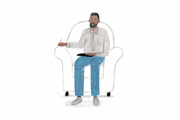Explore therapy 101 topics
Therapy 101
Congratulations on being curious about therapy, counseling, and mental health support.
Perhaps you have mental health questions, such as what are the different types of therapy and how do I figure out if I need to see a therapist?
It's our hope that the science-backed mental health articles we're publishing on Monarch can help demystify therapy and behavioral health for everyone.

1. How to find a therapist near you
With a network of over 100,000 mental health professionals, the Monarch directory by SimplePractice makes it easy for you to find licensed therapists and counselors near you.

Many therapists on Monarch accept health insurance and offer online booking, in-person or teletherapy video sessions, and free 15-minute initial consultations.
2. How do you know when to seek help from a therapist?
It’s important to know that you don’t have to be diagnosed with a mental disorder (or even think you have one) to benefit from psychotherapy.
In fact, you don’t even need to feel like “something’s wrong” to go to therapy. Plenty of people choose to go to therapy to support and maintain their mental health.
Most people who undergo psychotherapy experience symptom improvement and improve their ability to function in their daily lives. Here’s info on how and why therapy works.
Therapists are trained to use clinically validated methods to help you develop healthy, more successful behaviors.
Take this 3-minute online assessment to see if you would benefit from seeing a therapist.
3. Why do people see a therapist or counselor?
People go to therapy for all kinds of reasons, including:
You might have an overwhelming and prolonged feeling of sadness and helplessness. Or you might feel hopeless.
Your emotional problems may make it tough to operate on a day-to-day basis. For example, you may struggle to focus on work responsibilities, and as a consequence, your job performance could be suffering.
You could be behaving in ways that harm yourself or others. For example, you may abuse substances such as alcohol or drugs.
You may want to improve your relationships.
You might need help navigating a messy divorce or breakup.
You could want help regulating your emotions.
You might get promoted to a senior position at work and want help managing the additional responsibilities.
You may want parenting support.
You might have an elderly parent that you care for and need help making decisions
You could have a family member dealing with addiction issues
You might find out your spouse has been having an affair and need help to move forward.
That said, most people decide to go to therapy when they notice changes in their behavior and want the advice and support of a mental health professional to help make sense of the changes and better understand the reasons.

4. Mental health warning signs for adults
According to Mental Health America, it's important to pay attention to sudden changes in thoughts and behavior. Here are some of the common warning signs of a possible mental health problem:
You experience sudden changes in your sleep cycle or sleep hygiene.
Your appetite changes.
You have trouble focusing and completing tasks.
You become less productive at work or at home.
You notice frequent shifts in your mood.
You develop feelings of apathy towards engaging with other people or in social events, parties, sports, etc.
You’re having nervous, or anxious feelings that don’t have any obvious cause.
You have unexplainable physical aches or pains—these are often a physical manifestation of common mental illnesses, such as depression.
5. Common mental health warning signs for children
Here are some common signs and symptoms that a child may be struggling emotionally and could be in need of therapy or counseling:
Developmental regressions in things like speech, language, or bedwetting.
Conduct problems including fighting, bullying, acting out, vandalism, or theft.
Decreased interest in activities they previously enjoyed.
Prolonged bouts of sadness.
Drop in grades.
Loss of appetite.
Substance abuse.
Difficulty sleeping or excessive sleepiness.
Extreme shyness.
Excessive tardiness or absences from school.

6. Common mental health disorders
Here are some of the most common mental disorders, with links to more in-depth information on each:
Attention Deficit Hyperactivity Disorder (ADHD) - Attention or difficulty staying on task, hyperactivity or constantly being in motion or talking, impulsivity (e.g., often not thinking before acting).
Autism Spectrum Disorder (ASD) - Impaired communication, cognition, social interaction, with various levels of restricted, repetitive behavior, focus, and actions.
Bipolar Disorder - Recurring episodes of highs (mania) and lows (depression) in mood, along with changes in energy and behavior, extreme irritability or elevated mood.
Borderline Personality Disorder (BPD) - Intense emotions and mood swings, harmful, impulsive behaviors, unhealthy relationships, low self-worth, an intense fear of being abandoned, and aggressive behavior.
Generalized Anxiety Disorder (GAD) - An overwhelming sense of worry. Physical symptoms often include fatigue, headaches, muscle aches, trouble swallowing, trembling, twitching, irritability, sweating, lightheadedness, nausea, and hot flashes.
Depression or Major Depressive Disorder (MDD) - An overwhelming sense of sadness and loss of interest or pleasure in most activities that interferes with the ability to work, sleep, and eat. Negative impact on a person’s thoughts, sense of self-worth, sleep, and energy-level.
Post-Traumatic Stress Disorder (PTSD) - Relived trauma after experiencing a horrific event, through nightmares or disturbing thoughts, feelings of detachment, numbness, irritability, or aggressiveness.
Schizophrenia - Hearing voices or having hallucinations that cause the individuals experiencing them to feel frightened, anxious, and confused.
7. What type of therapist should I see?
“Therapist” is a general term that refers to any mental health professional trained to help clients deal with emotional and behavioral health issues. Therapists can have a variety of titles (counselors, therapists, clinicians, etc.).
What they have in common is that they all have education and licensing a master’s (M.A. or M.S.) or doctoral degree (Ph.D. or Psy.D.) in clinical psychology or a related field and are licensed in the state in which they practice.
There are several types of mental health professionals licensed to provide talk therapy to clients, including:
Psychologist (Ph.D or Psy.D)
Licensed Marriage and Family Therapist (LMFT)
Licensed Clinical Social Worker (LCSW)
Licensed Professional Counselor (LPC)
Psychiatrist (M.D.)
While specific titles and specialties differ by state, these are the major categories of mental health professionals.
A psychologist specifically refers to someone with a doctoral degree in psychology.
In the past, psychiatrists were more likely to provide therapy and medication.
However, now most psychiatrists only prescribe medication and have not been trained to provide talk therapy.
This means that if you are looking for a therapist, you would most likely be looking for a psychologist or other mental health professional such as a marriage and family therapist, social worker, or mental health counselor.
Here is more in-depth info on the different types of therapists and mental health professionals.
8. Different therapeutic approaches
If you're wondering about which of the different types of therapy is right for your needs, first there are a few key questions to ask yourself:
Do you want to understand yourself better?
Do you want to change the way you act?
Do you want to be supported?
You don’t have to choose just one—your answer can be a combination of all three.
However, typically one is most important in terms of your specific needs.

What is talk therapy?
Talk therapy or psychotherapy is an umbrella term that encompasses many varieties of therapy.
Cognitive behavioral therapy (CBT)
One type of talk therapy is cognitive behavioral therapy (CBT).
CBT is considered as effective as medication for treating anxiety, depression, obsessive-compulsive disorder, post-traumatic stress disorder, and substance abuse.
Psychoanalysis and psychodynamic therapy
Both of these types of therapy are based on the work of Sigmund Freud and are considered styles of traditional talk therapy.
Psychodynamic therapy focuses on the psychological roots of emotional suffering and uses self-reflection and self-examination as tools for discovery.
Psychoanalysis looks at the interaction between the conscious and unconscious aspects of the mind and will use techniques like dream interpretation to better understand repressed emotions. This type of therapy is considered an intensive, long-term approach to healing.
Dialectical behavioral therapy (DBT)
Dialectical behavioral therapy (DBT) is a type of CBT that combines multiple strategies like mindfulness and emotional regulation to bring about acceptance and change.
The specific skills emphasized in DBT include:
Mindfulness,
Tolerating distress,
Emotion regulation
Interpersonal effectiveness.
While it's considered the treatment of choice for borderline personality disorder (BPD), dialectical behavioral therapy has also been shown to be effective for a variety of other issues such as addiction, depression, and post-traumatic stress disorder or PTSD.
Acceptance and commitment therapy (ACT)
Acceptance and Commitment Therapy (ACT, pronounced “act”) is a type of therapy that encourages us to accept or embrace the thoughts and feelings they are having instead of running away from them.
ACT therapy uses strategies to keep us in the present moment of what is being experienced, with the idea that acceptance and commitment will then facilitate a behavior change process. While CBT teaches us how to better control our thoughts, feelings, sensations, memories, and so on, the ACT style of therapy teaches us notice, accept, and embrace our private feelings.
Mindfulness-based therapy (MBT)
Therapists who practice mindfulness-based therapy (MBT) teach us mindfulness activities like meditation and breathing exercises, while teaching us to let go of self-judgment.
MBT encourages consciously observing thoughts and feelings as a form of discovery and a way to let go of negative beliefs.
Meaning-centered therapy
Meaning-centered therapy is a newer form of therapy used mostly by therapists treating those suffering from serious illness. It combines spiritual well-being and quality of life as a way to look at an enhanced meaning for a happier life, and ideally decrease or release suffering.
Eye movement desensitization and reprocessing (EMDR)
Eye movement desensitization and reprocessing (EMDR) is an interactive type of therapy that helps people with post-traumatic stress disorder (PTSD).
During an EMDR session, the client is instructed to recall distressing events while simultaneously tracking the therapist’s fingers (which are moved from side to side) with their eyes.
The resulting stimulation is thought to trigger the brain’s information processing channels, enabling more adaptive associations to be made. Eventually, this pushes traumatic events into long-term memory. As a result, people become desensitized to the trauma and can lead a better life.
Humanistic therapy
Humanistic therapy is a style of therapy that emphasizes a “holistic approach” to improving mental well-being. It involves learning more about your views and beliefs in order to develop true self-acceptance and recognizes a core belief that people are innately good with the ability to make the right choices for themselves.
Humanistic therapy is used to treat depression, anxiety, panic disorders, personality disorders, schizophrenia, addiction issues, and relationship issues.
Prolonged exposure therapy
Prolonged exposure therapy (PE) is a form of CBT that emphasizes reprogramming traumatic experiences to feel safe.
By learning to sit with a past experience while repeating and recounting the traumatic memories, a person realizes it is safe and can then begin to heal.
What about telehealth video therapy and text-based therapy?
In telehealth video therapy sessions, you will talk directly with a therapist in real time using video on your computer, tablet, or mobile phone.
Text based therapy is a newer form of therapy that is completely virtual. And while this type of therapy is operated by licensed professionals, there are some aspects of AI (Artificial Intelligence) that will guide the conversation.

9. Paying for therapy
Wondering how to pay for therapy?
We get it! That said, we hope the cost of therapy won't stop you from reaching out for help.
Many therapists offer reduced or sliding scale fees based on your income, and you might have benefits through health insurance that can help make therapy more affordable.
Is therapy covered by health insurance?
It’s estimated that about half of therapists in private practice accept some insurance.
Here's how to find a therapist who accepts your insurance.
While some therapists have 100% of their clients pay with insurance, some only reserve a few slots for insurance clients.
This means that it may take a bit more effort to find a therapist that accepts your insurance and is also accepting new clients.
What is an “in-network” therapist vs an “out-of-network” therapist?
If you want to use your health insurance to help pay for therapy, you essentially have two options: to see a therapist who is “in-network” or one that is “out-of-network”.
An “in-network” therapist has a contract with a specific insurance company and has agreed to provide services at a specific price to the insurance company’s members. I
If your therapist is “out-of-network”, this means that you are responsible for the full payment at the end of each session. Your therapist then gives you a “superbill” or invoice that you would submit to your insurance to get a portion reimbursed. Your insurance may still reimburse a portion or all of the cost of your therapy, depending on your plan’s benefits.
There are pros and cons to using your health insurance to pay for therapy. But the first step to deciding if you should use insurance is to call the number on the back of your ID card to confirm your coverage.
Calling your insurance company
Here are the key questions you need to ask:
Is there a yearly limit or a deductible you need to be aware of?
Do they cover 100% of costs or just a percentage?
Do you need a physician referral before you are eligible for coverage?
Are there certain therapists who they will or will not cover (i.e., do they need to have certain credentials)?
Are there co-pay options or will you have to pay upfront first then submit receipts for reimbursement?
By contacting your insurance company first, they can let you know what they cover under your health plan and direct you to professionals in your area that are approved providers.
Paying out of pocket
How much does it cost to go to therapy without insurance?
The other way to pay for therapy is what’s called “self-pay”. This means exactly as it sounds self (you) pay, as opposed to using your health insurance. Some people prefer this option simply because it gives you more control. When you pay, you make the calls, not the insurance company.
Another reason people choose to “self-pay” is for privacy reasons. When you pay, no information is exchanged with your insurance company, therefore everything stays between you and your therapist.
The obvious downside to “self-pay” is not everyone can afford to pay $135 for 50 minutes of therapy every week. However, to help make self-pay therapy more affordable, some therapists offer a sliding scale rate.
What is a sliding scale rate for therapy?
A sliding scale rate is a reduction in the total costs based on the recipient's financial needs. If your income is below a set amount, and/or you have a large family, you may qualify for a lower rate.
To find out if this is an option, all you have to do is ask: “Do you offer a sliding scale?” Don’t be afraid to ask; this is a very common question that therapists get asked all the time.
10. What can you expect from therapy?
A therapist will usually encourage you to share what's been going on in your life, what's on your mind, what's troubling you, or what you'd like to explore at the start of a session. He or she will listen to you with encouragement and without judgment. This is your chance to be vulnerable and authentic, to express exactly what you've been dealing with, what brought you to therapy.
Everything you share in session is completely confidential. Every therapist and every client is unique, but in the beginning the goal is really to get to know each other so that I can truly understand what is preventing you from being the best version of yourself.

11. What do you do at your first therapy session?
The initial session with a counselor or therapist will be focused on establishing a connection, getting to know one another, defining goals, and providing you with a sense of hope for the future.
Your therapist will start by having you fill out some paperwork if you haven’t already done so. It’s very important that you read everything carefully.
Then your therapist will probably review the responses from your intake paperwork and find out more about the reason for your visit. Be as honest as possible, keeping in mind that the conversation is confidential, and that your therapist is interested in helping you to feel better.
Most therapists take notes during sessions to document and track your progress, especially at the first session. They often will note the significant dates, names of important people, and descriptions of your symptoms.
Sometimes, especially in telehealth sessions, your therapist will look away to jot down a note. This is very common and doesn’t mean they aren’t listening to you. Sometimes clients are bothered by this because it may come across as though your therapist is not listening or distracted.
Questions your therapist may ask include:
What are your current life circumstances?
Have you had any therapy before? If so, when and what was your experience like?
How’s your health?
What medications are you currently taking?
How much alcohol do you drink?
Do you use any recreational drugs?
Do you have any family history of depression or substance use?
What are your symptoms?
How have you tried to manage them?
What are your goals for therapy or counseling?
How can I be most helpful to you at this time?
Your therapist will also go over their practice policies and information about the confidential nature of your sessions.
Remember, the first session is just a starting point. It’s simply an opportunity for you and your therapist to get to know each other, so be prepared to do a lot of talking.
12. What should I say in my first therapy session?
Your therapist will guide you through your first session, so there’s no need to worry about keeping the conversation going. Whatever comes to mind is always the best bet.
If there’s something weighing heavy on you that feels important to share, speak up. Remember, there’s no right or wrong here, so your answers should be truly how you feel. And if you don’t know, it’s okay to say that too.

Related articles about therapy 101

Whether you’re working through some things and need an objective, supportive point of view, or you’re having a hard time and are ready to get treatment, you took the initiative to request an appointment to see a therapist.

How long will you have to be in therapy? What are the factors that determine how long you’ll be on the couch?

Spilling your guts to a computer screen can feel…weird. Here are some tips for making it as un-weird as possible.

What is acceptance and commitment therapy (ACT), and how can it help you? (Hint: It probably can.)